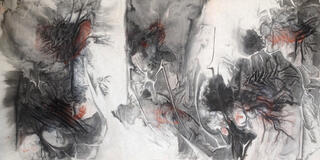Made In China: Ming to Mass Market & Ming Ren: Mysterious Ink World

Oct. 19, 2012 to Dec. 14, 2012
Viewed together, Made in China: Ming to Mass Market and Ming Ren: Mysterious Ink World invite viewers to consider the journey of tradition. They remind us that traditions are as fluid as time, created through circumstance: materials, culture, location and the sharing—blending—of aesthetics. Guest curated by Ellen Huang, Ph.D., Kiriyama Teaching Fellow, Center for the Pacific Rim, University of San Francisco.
Made in China: Ming to Mass Market
Presenting ceramic ware primarily from the 18th century to the present, Made in China: Ming to Mass Market invites viewers to contemplate the porcelain tradition in high art and the mass market. Made in China features porcelain vessels from the Asian Art Museum and private collectors.
Curator’s Introduction
Made in China: Ming to Mass Market presents ceramic ware from around the world dating from the 17th century to the present, introducing the materials, traditions and aesthetic ideals that led to the world-wide production and consumption of porcelain, or
what many of us simply call “china.”
Visually, porcelain is renowned for its pure white, translucent quality that suggests fragility. Materially, it is a dense, hard material made of finely-ground and heated clay. Its origins in China can be traced as far back as 8000 BCE. While the popular term “china” merges the ideas of porcelain, mass-market dishware and the country of their origins into one, the history of porcelain has always been a global phenomenon. Porcelain may have begun in China, but its desirability led to the spread of its production and trade across continents where it took on the aesthetics and uses of each market. The objects on display here come from lands as distant and diverse as Iran, Japan, Korea, Vietnam, France and Germany as well as China.
Beyond geographical boundaries, porcelain’s impact encompassed a variety of techniques and mediums. China’s early ceramic traditions were based heavily on location and natural resources, while European traditions and means of identification were based on chemistry and firing temperatures. In both cases, the resulting surfaces allow for a variety of decorative qualities. This exhibition shifts the usual focus on Ming dynasty (1368-1644) blue-and-white ware that is synonymous with “china” to include intricate polychrome and enamel pieces of the Qing dynasty (1644-1911). The variety of mediums you will see may at first be surprising. In addition to porcelain, the exhibit features lively painted enamels on metal, rustic earthenware, and elegant stoneware, all of which reflect the porcelain aesthetic in high art and the mass market.
This art form belongs as much to material culture as to fine arts. Even today, porcelain objects continue to be manufactured and consumed for their sturdiness as well as their beauty. Perhaps nowhere is its material quality more evident than in the shards from
the shipwreck of the San Felipe galleon, lost while transporting Chinese goods from the Philippines to Spanish colonies in the Americas. The ship and the people who set sail in 1576 never made it to port, while the ship’s fragile and refined porcelain cargo
survived buried in the sands of Baja California for over 400 years.
— Ellen Huang, Ph.D., Kiriyama Teaching Fellow, Center for the Pacific Rim, University of San Francisco
About the curator
Curator Ellen Huang, Ph.D., Kiriyama Teaching Fellow at USF’s Center for the Pacific Rim, explains that despite the prevalence of the popular pun connecting china dishware to China, the history of porcelain from China has always been a global phenomenon. Its extensive trade allowed for a sharing of techniques and aesthetics between China and Europe, Iran, Japan and elsewhere in Asia. This exhibition, showcasing a number of pieces from the Asian Art Museum alongside pieces from Fine Arts Museums of San Francisco, the Instituto Nacional de Anthropologia y Historia and a private collector, highlights the importance of this phenomenon in the history of porcelain and ceramics in general.
Ming Ren: Mysterious Ink World
The coinciding exhibition, Ming Ren: Mysterious Ink World, features large-scale abstract canvas paintings by Chinese-trained artist Ming Ren. Using monochrome ink and pigments, these paintings take traditional Chinese calligraphy and brush painting in new directions that “hover between a traditional Zen art form and Western art of the twentieth century.” Ming Ren’s paintings have been described as landscapes, memories of a journey never taken and paradoxical puzzles of space and locale. They are at once abstract and familiar, deliberate and surprising, nostalgic and contemporary. What we see is an individual artist’s journey through the mysteries of tradition.
About the artist
Ming Ren is a professor and special assistant to the President for China Affairs for the San Francisco Art Institute and California College of Arts. His award-winning works have been exhibited internationally, including at the Florence Biennial International Exhibition in Contemporary Art and the Huantie Time Art Museum in Beijing. The San Francisco Asian Art Museum has three of his works in its permanent collection.
Major Events
- Lecture by Curator Dr. Ellen Huang & Artist Ming Ren
Tuesday, October 23 | 2:45–3:45 p.m. | 250 McLaren Hall, followed by a reception in Thacher Gallery. - Tour and reception with Curator Dr. Ellen Huang
Monday, November 5 | 12–1 p.m. | Thacher Gallery.
Presented by the USF Ricci Institute for Chinese-Western Cultural History